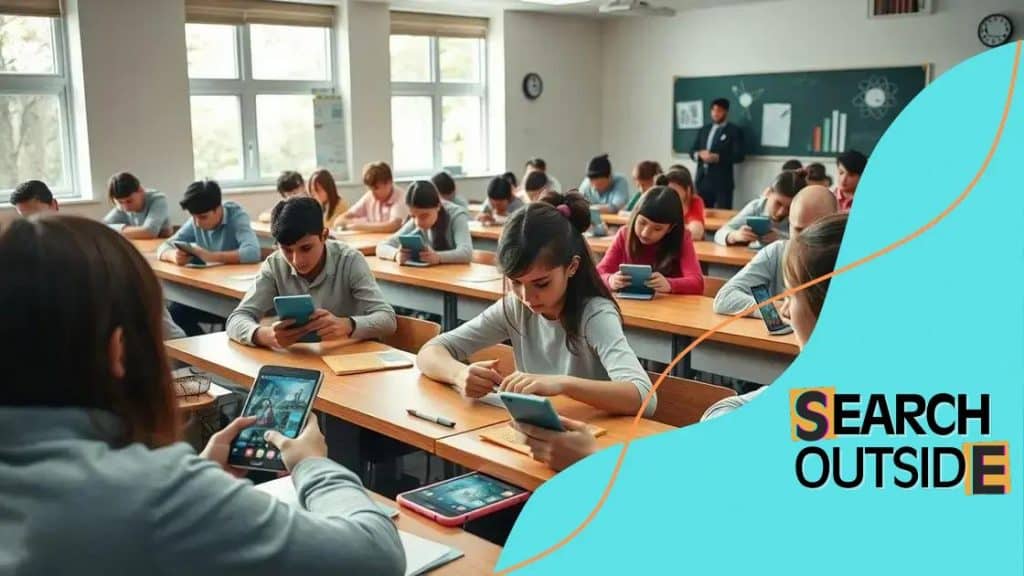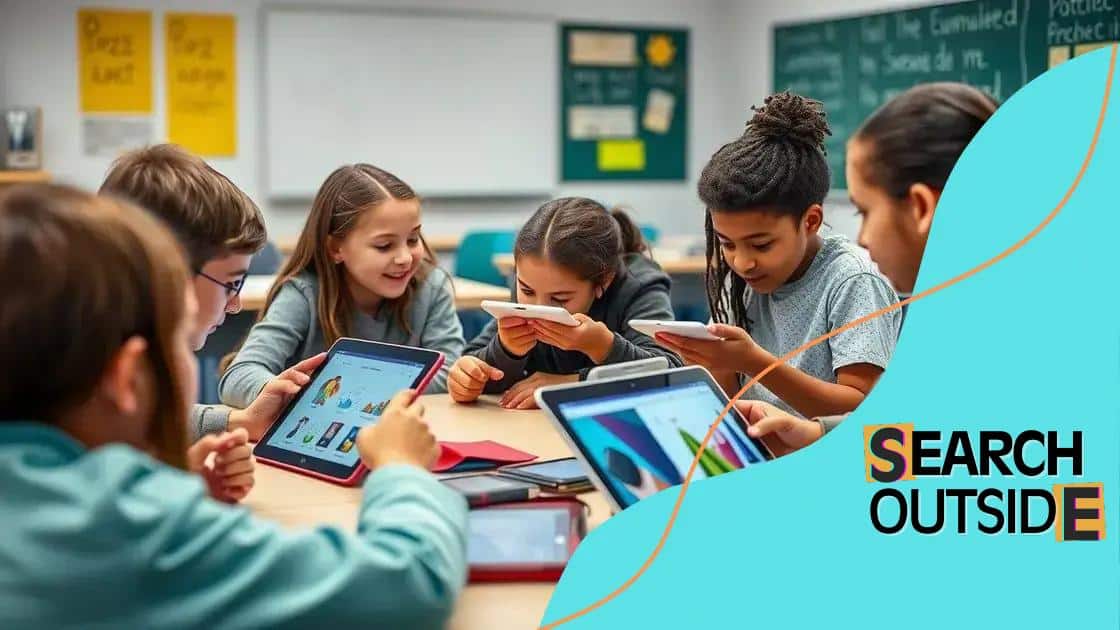The role of mobile apps in enhancing student learning

The role of mobile apps in enhancing student learning includes personalized education through AI, immersive experiences with AR/VR, and increased engagement via gamification, while facing challenges like accessibility and content quality.
The role of mobile apps in enhancing student learning is a topic that’s gaining momentum. Have you ever wondered how your smartphone could become a powerful learning tool? Let’s dive into the ways mobile applications are reshaping education.
Understanding the impact of mobile apps on education
Understanding the impact of mobile apps on education is crucial in today’s tech-driven world. These apps are changing the way students learn and engage with material.
Enhanced Accessibility
One of the primary benefits of mobile apps is enhanced accessibility. Students can access learning materials anytime and anywhere, making it easier for them to study at their own pace. This flexibility is especially valuable for those who may struggle in traditional classroom settings.
Interactive Learning Experiences
Mobile apps often provide interactive elements that traditional textbooks cannot offer. For instance, gamified learning can make subjects like math and science more engaging. When students can see real-life applications of their studies, they are more likely to retain information.
- Gamification increases student motivation.
- Interactive quizzes help assess knowledge.
- Multimedia content appeals to various learning styles.
Moreover, the integration of video and animations creates a dynamic learning environment. Students can participate in guided tutorials that provide instant feedback, which helps in mastering difficult concepts.
Collaboration and Communication
Collaboration tools embedded in educational apps facilitate communication among students and teachers. Group projects become more manageable when students can share resources and discuss ideas in real-time. This leads to a more collaborative learning experience.
Additionally, platforms like forums and chat systems allow for a continuous exchange of ideas, making learning a shared journey.
Challenges and Considerations
While mobile apps open up numerous possibilities, there are challenges too. Not all students have equal access to technology, creating disparities in the learning experience. Schools must consider how to provide tools for all students to ensure equitable education.
In summary, understanding the impact of mobile apps on education reveals a landscape that offers both advantages and challenges. By leveraging these tools wisely, we can create an enriched learning environment.
Key features of effective educational apps
Key features of effective educational apps significantly enhance student learning experiences. These features contribute to a more engaging and productive learning environment.
User-Friendly Interface
An intuitive design is essential for any educational app. Students should easily navigate through courses and materials. A user-friendly interface can help reduce frustration and increase the time spent learning.
Interactive Elements
Interactive features are vital in keeping students engaged. Apps can incorporate quizzes, games, and simulations that allow users to apply what they have learned. This active participation increases retention and understanding.
- Real-time feedback from quizzes helps identify strengths and weaknesses.
- Gamification elements motivate learners through rewards and challenges.
- Interactive tutorials provide step-by-step guidance.
Furthermore, the ability to track progress is crucial for students. Effective apps often include dashboards that show achievements and areas needing improvement. This feature encourages self-directed learning.
Accessibility Across Devices
Another key feature is cross-device compatibility. Students should be able to switch from a smartphone to a tablet or laptop seamlessly. This flexibility ensures that learners have access to educational materials whenever they need them.
Furthermore, effective educational apps often offer offline access, allowing students to download content. This is particularly important for students in areas with limited internet connectivity.
Social Learning Opportunities
Incorporating social features, such as forums or collaborative projects, allows students to communicate and learn from one another. This enhances the learning process by promoting discussion and sharing of ideas.
Incorporating features like these into educational apps creates a more enriching experience for learners. The combination of usability, interactivity, and connectivity helps students thrive.
Case studies of successful app integration in classrooms

Case studies of successful app integration in classrooms showcase the effective use of technology to enhance learning. These examples demonstrate how mobile applications can make education more interactive and engaging.
Example 1: Flipped Classroom Model
One notable case is the flipped classroom model implemented at a high school in California. Teachers assigned video lessons through an educational app for homework. In class, students engaged in discussions and applied concepts actively. This approach improved students’ understanding and increased their participation.
Example 2: Collaborative Learning
Another example comes from a middle school in New York that used an app to foster collaborative projects. Students worked in groups on a science project using the app to research, create presentations, and get feedback from peers. The app not only encouraged teamwork but also helped develop critical communication skills.
- Students reported higher engagement levels.
- Teachers noted improved group dynamics.
- The project outcomes reflected higher quality work.
These cases highlight how integrating apps can lead to enhanced educational experiences. In addition to presenting information, these apps support collaboration and creativity among students.
Example 3: Language Learning
In a language learning program, an app helped students practice pronunciation and vocabulary through games. The instant feedback feature promoted confidence as learners tackled difficult words. As a result, students showed significant improvements in their speaking abilities, encouraging them to use the language more regularly.
Such case studies exemplify the potential of educational apps to transform traditional teaching methods into vibrant learning experiences. By facilitating active participation and engagement, these technologies foster a more effective classroom environment.
Challenges faced in adopting mobile learning apps
Challenges faced in adopting mobile learning apps can impact the effectiveness of technology in education. Recognizing these obstacles is essential for successful implementation.
Access to Technology
One significant challenge is ensuring equitable access to devices and internet connectivity. Many students may not have smartphones or tablets, making it difficult for them to participate fully. Schools in low-income areas often struggle to provide technology for all students.
Technological Literacy
Another obstacle is the level of technological literacy among both students and teachers. Not everyone is familiar with how to use educational apps effectively. Training programs are often needed to help educators integrate these tools into their teaching successfully.
- Teachers might need guidance on app selection and usage.
- Students may require tutorials to navigate apps successfully.
- Ongoing support is critical for sustained use.
Furthermore, resistance to change can hinder the adoption of mobile apps. Some educators may prefer traditional teaching methods, fearing that technology could disrupt their established routines.
Content Quality and Relevance
Another challenge is ensuring that the content available through mobile apps is high-quality and relevant. Not all educational apps meet the necessary standards for learning. Schools must carefully vet apps before implementation to ensure they align with educational goals.
In addition, maintaining consistent updates and improvements for these apps can be costly and time-consuming, leading to potential gaps in learning resources. As technology evolves quickly, keeping educational content current is a continuous challenge.
By addressing these challenges, schools can better facilitate the successful integration of mobile learning apps into their educational frameworks. Understanding the barriers helps in planning and executing a more effective adoption strategy for technology in classrooms.
Future trends in mobile education technology
Future trends in mobile education technology are poised to transform how students learn and interact with content. As technology advances, there are several exciting developments on the horizon.
Artificial Intelligence and Personalization
One major trend is the use of artificial intelligence (AI) to create personalized learning experiences. AI can analyze student data to tailor educational content according to individual needs. This personalization allows students to learn at their own pace and provides targeted support in areas where they may struggle.
Augmented and Virtual Reality
Another emerging trend is the incorporation of augmented reality (AR) and virtual reality (VR)
Moreover, the rise of learning analytics is another significant trend. Educators can use data collected from mobile apps to monitor student progress and identify learning patterns. This information can inform teaching strategies and improve overall educational outcomes. Gamification continues to be a powerful method to increase student engagement. By incorporating game-like elements, such as points, badges, and leaderboards, educational apps motivate students to participate actively. This fun approach can make challenging subjects more enjoyable and less intimidating. In addition, mobile education technologies will likely expand to improve accessibility for diverse learners. Apps will increasingly offer features like text-to-speech, adjustable text sizes, and multilingual support to cater to varying needs. As these trends evolve, the integration of mobile education technology will pave the way for innovative teaching and learning strategies, opening doors for future generations. In conclusion, the future of mobile education technology looks bright with trends like artificial intelligence, augmented reality, and gamification reshaping learning experiences. Educators can now create personalized and engaging environments that cater to individual student needs. However, challenges remain, such as ensuring accessibility and high-quality content. By embracing these innovations, we can enhance education and prepare students for a technology-driven world. Artificial intelligence personalizes learning experiences by analyzing student data to tailor educational content to individual needs. They provide immersive experiences that engage students deeply with the material, making learning more interactive and memorable. Gamification motivates students by incorporating game-like elements, which can make challenging subjects more enjoyable. Challenges include ensuring access to technology, teacher training, and maintaining high-quality content across apps.
Gamification in Education
FAQ – Questions about Mobile Education Technology
What is the role of artificial intelligence in mobile education?
How do augmented and virtual reality enhance education?
What are the benefits of gamification in educational apps?
What challenges are faced when adopting mobile learning apps?





